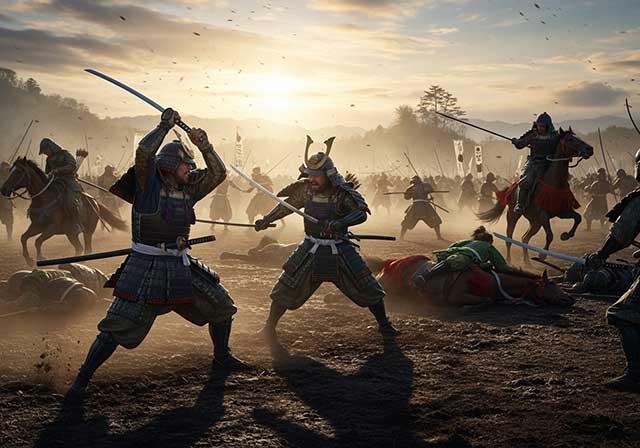
By the summer of 1556, Oda Nobunaga no longer appeared to be the eccentric “great fool of Owari.” Four years earlier, in 1552, having just assumed the position of clan leader, he managed to defend his position: first in the Battle of Akatsuka, and then at Kayazu Fort. In 1553, together with his western neighbor and ally Saito Dosan, his father-in-law, Nobunaga successfully repelled an attack by the Imagawa clan on the border fort of Muraki. In 1554, he united his own branch of the family with the Kiyosu line. Step by step, the young military leader strengthened his position.
But much more severe trials awaited him ahead. In 1556, Nobunaga's relationship with his younger brother Nobukatsu (1536–1557) finally came to a head. Most of the clan elders sided with Nobukatsu, including the most influential of them, Hayashi Hidesada. There is a theory that it was Hidesada who was behind this conspiracy, hoping to turn Nobukatsu into an obedient puppet, unlike the wayward and independent Nobunaga. It is important to remember that this was already his second attempt to depose Nobuhide's eldest son — he had made his first attempt back in 1552.
At some point, Nobukatsu began to behave like the head of the clan. For Nobunaga, this was a clear signal that a coup was being prepared. He gathered his loyal warriors around him and prepared for battle.
On August 24, 1556, the decisive battle took place in Inogahara, just five kilometers east of Kiyosu Castle. Those familiar with 16th-century Japanese history know about the famous Battle of Okehazama, where Nobunaga, with fewer forces, defeated the powerful Imagawa Yoshimoto. However, few remember that Nobunaga began to master the art of striking precisely at the enemy's weak points much earlier — in battles for the unification and strengthening of his clan.
In the Battle of Inogahara, the older generation almost unanimously supported Nobukatsu, which made Nobunaga's position extremely dangerous. The battle began around noon when a detachment of a thousand warriors under the command of Shibata Katsuie attacked Nobunaga's positions. But numerical superiority was not decisive. The fighting spirit of Nobukatsu's warriors was weak: many did not understand why they were fighting against the legitimate head of the clan. According to the description of the family chronicler Ota Gyuichi, Nobunaga loudly berated the traitors with fierce insults during the battle. His commanding voice, which they were accustomed to obeying, finally broke their resolve. Katsuiye's warriors began to slow down their advance and soon fled altogether.
But the battle did not end there. The second part of the battle unfolded a little further south, where Nobunaga's army clashed with a detachment commanded by Hayashi Mimasaka, Hidesada's younger brother. According to Ota Gyūichi, the battle began with a duel between the commanders. Kuroda Hambay faced Mimasa, but he was defeated and lost his left arm. At this critical moment, Nobunaga himself saved the situation: according to one version, he replaced his fallen vassal and personally entered the fray, according to another, he unexpectedly attacked and defeated Mimasa. Seeing the death of their commander and Nobunaga's furious curses, the enemy troops lost what little courage they had left and fled in disorder. Thus, with only 700 soldiers against a much larger army, Nobunaga won the battle of Inogahara.
A few days later, Nobunaga's mother met with her eldest son and persuaded him to forgive Nobukatsu. Realizing that further family division would weaken his position, Nobunaga showed political foresight: he not only spared his brother, but also granted amnesty to the elders who had participated in the rebellion. This was a wise move that allowed him, after such a resounding victory, to further reduce the number of enemies within the clan.
As a result of the Battle of Inogahara, Nobunaga proved his right to leadership. His authority increased dramatically, and the number of enemies within the family decreased. Moreover, some of those who had recently opposed him, such as Shibata Katsuie, subsequently became his loyal allies and generals.
See also
-
The Siege of Hara Castle

The Shimabara Rebellion of 1637–1638, which culminated in the siege of Hara Castle, was the last major uprising of the Edo period and had serious political consequences.
-
Battle of Tennoji

The confrontation between Tokugawa Ieyasu and Toyotomi Hideyori during the “Osaka Winter Campaign” ended with the signing of a peace treaty. On January 22, 1615, the day after the treaty was signed, Ieyasu pretended to disband his army. In reality, this meant that the Shimazu forces withdrew to the nearest port. On the same day, almost the entire Tokugawa army began filling in the outer moat.
-
Siege of Shuri Castle

The Ryukyu Kingdom was established in 1429 on Okinawa, the largest island of the Ryukyu (Nansei) archipelago, as a result of the military unification of three rival kingdoms. In the following years, the state's control spread to all the islands of the archipelago.
-
The Siege of Fushimi Castle
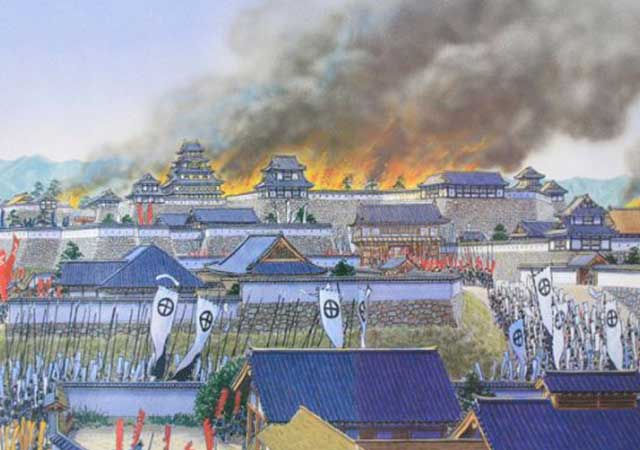
Fushimi can perhaps be considered one of the most “unfortunate” castles of the Sengoku Jidai period. The original castle was built by Toyotomi Hideyoshi in the southeast of Kyoto in 1594 as his residence in the imperial city.
-
The Siege of Otsu Castle
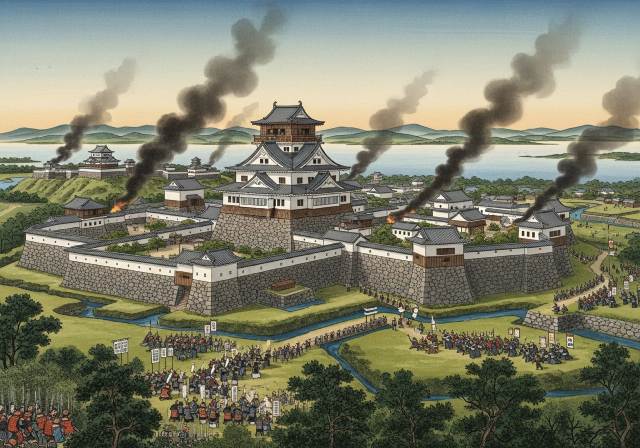
The siege of Otsu Castle was part of the Sekigahara campaign, during which the so-called Eastern Coalition, led by Tokugawa Ieyasu, fought against the Western Coalition, led by Ishida Mitsunari. Otsu Castle was built in 1586 by order of Toyotomi Hideyoshi near the capital Kyoto, on the site of the dismantled Sakamoto Castle. It belonged to the type of “water castles” — mizujō — as one side of it faced Japan's largest lake, Lake Biwa, and it was surrounded by a system of moats filled with lake water, which made the fortress resemble an island.
-
The Siege of Shiroishi Castle
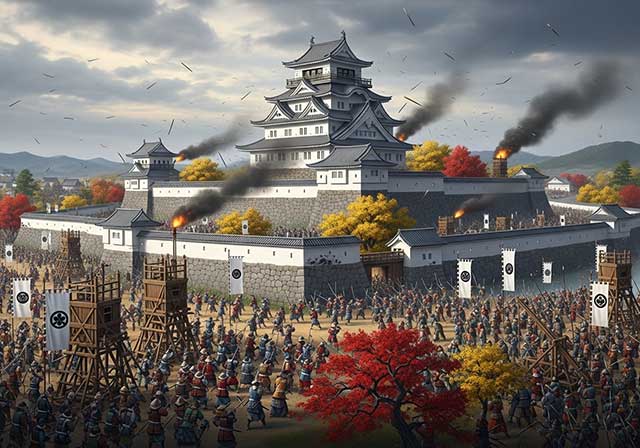
The siege of Shiroishi Castle was part of the Sekigahara campaign and took place several months before the decisive battle of Sekigahara. The daimyo of Aizu Province, Uesugi Kagekatsu, posed a serious threat to Tokugawa Ieyasu's plans to defeat the Western Coalition, and Ieyasu decided to curb his actions with the help of his northern vassals. To this end, he ordered Date Masamune to invade the province of Aizu and capture Shiroishi Castle.
-
The Second Siege of Jinju Castle
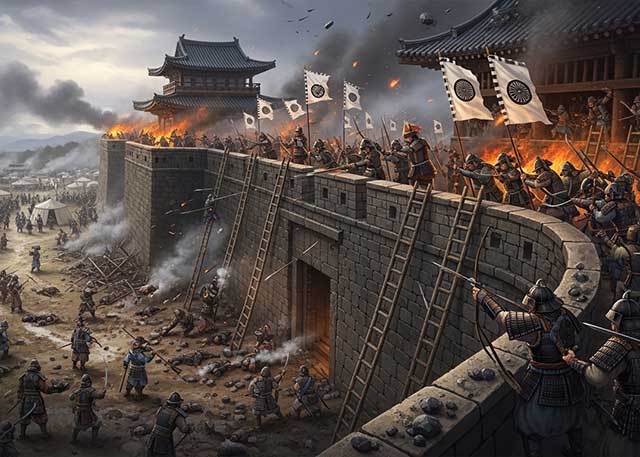
During the two Korean campaigns of the 16th century, the Japanese repeatedly had to capture enemy fortresses and defend occupied or constructed fortifications from the combined Korean and Chinese forces. Among all the operations of that time, the second siege of Jinju Castle is considered the most interesting from the point of view of siege warfare.
-
The Siege of Takamatsu Castle
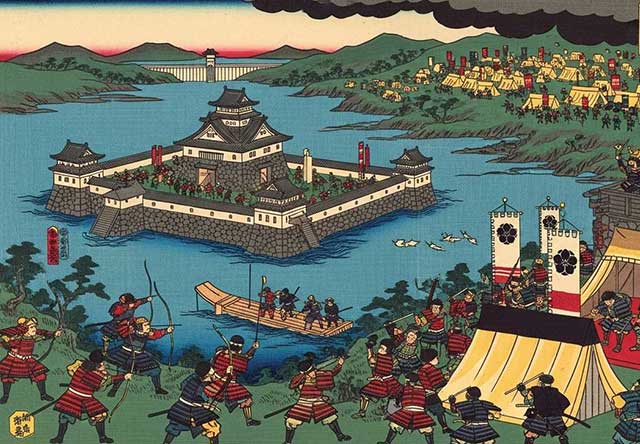
The siege of Takamatsu Castle in Bitchu Province is considered the first mizuzeme, or “water siege,” in Japanese history. Until then, such an original tactic had never been used.

